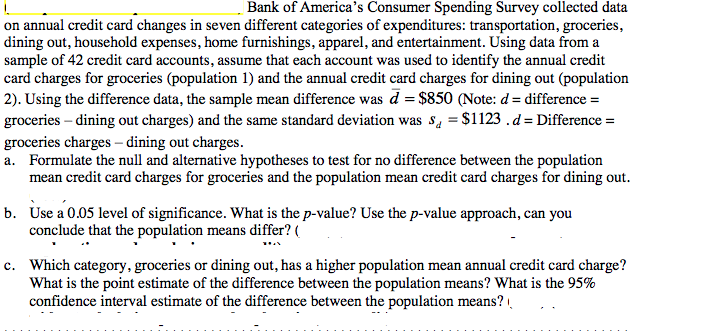|Bank of America's Consumer Spending Survey collected data on annual credit card changes in seven different categories of expenditures: transportation, groceries, dining out, household expenses, home furnishings, apparel, and entertainment. Using data from a sample of 42 credit card accounts, assume that each account was used to identify the annual credit card charges for groceries (population 1) and the annual credit card charges for dining out (population 2). Using the difference data, the sample mean difference was d = $850 (Note: d= difference = groceries – dining out charges) and the same standard deviation was s, = $1123 .d= Difference = groceries charges – dining out charges. a. Formulate the null and alternative hypotheses to test for no difference between the population mean credit card charges for groceries and the population mean credit card charges for dining out. b. Use a 0.05 level of significance. What is the p-value? Use the p-value approach, can you conclude that the population means differ? c. Which category, groceries or dining out, has a higher population mean annual credit card charge? What is the point estimate of the difference between the population means? What is the 95% confidence interval estimate of the difference between the population means?
|Bank of America's Consumer Spending Survey collected data on annual credit card changes in seven different categories of expenditures: transportation, groceries, dining out, household expenses, home furnishings, apparel, and entertainment. Using data from a sample of 42 credit card accounts, assume that each account was used to identify the annual credit card charges for groceries (population 1) and the annual credit card charges for dining out (population 2). Using the difference data, the sample mean difference was d = $850 (Note: d= difference = groceries – dining out charges) and the same standard deviation was s, = $1123 .d= Difference = groceries charges – dining out charges. a. Formulate the null and alternative hypotheses to test for no difference between the population mean credit card charges for groceries and the population mean credit card charges for dining out. b. Use a 0.05 level of significance. What is the p-value? Use the p-value approach, can you conclude that the population means differ? c. Which category, groceries or dining out, has a higher population mean annual credit card charge? What is the point estimate of the difference between the population means? What is the 95% confidence interval estimate of the difference between the population means?
Holt Mcdougal Larson Pre-algebra: Student Edition 2012
1st Edition
ISBN:9780547587776
Author:HOLT MCDOUGAL
Publisher:HOLT MCDOUGAL
Chapter11: Data Analysis And Probability
Section11.4: Collecting Data
Problem 5E
Related questions
Question

Transcribed Image Text:|Bank of America's Consumer Spending Survey collected data
on annual credit card changes in seven different categories of expenditures: transportation, groceries,
dining out, household expenses, home furnishings, apparel, and entertainment. Using data from a
sample of 42 credit card accounts, assume that each account was used to identify the annual credit
card charges for groceries (population 1) and the annual credit card charges for dining out (population
2). Using the difference data, the sample mean difference was d = $850 (Note: d= difference =
groceries – dining out charges) and the same standard deviation was s, = $1123 .d= Difference =
groceries charges – dining out charges.
a. Formulate the null and alternative hypotheses to test for no difference between the population
mean credit card charges for groceries and the population mean credit card charges for dining out.
b. Use a 0.05 level of significance. What is the p-value? Use the p-value approach, can you
conclude that the population means differ?
c. Which category, groceries or dining out, has a higher population mean annual credit card charge?
What is the point estimate of the difference between the population means? What is the 95%
confidence interval estimate of the difference between the population means?
Expert Solution
This question has been solved!
Explore an expertly crafted, step-by-step solution for a thorough understanding of key concepts.
This is a popular solution!
Trending now
This is a popular solution!
Step by step
Solved in 4 steps with 4 images

Recommended textbooks for you

Holt Mcdougal Larson Pre-algebra: Student Edition…
Algebra
ISBN:
9780547587776
Author:
HOLT MCDOUGAL
Publisher:
HOLT MCDOUGAL

Glencoe Algebra 1, Student Edition, 9780079039897…
Algebra
ISBN:
9780079039897
Author:
Carter
Publisher:
McGraw Hill

College Algebra (MindTap Course List)
Algebra
ISBN:
9781305652231
Author:
R. David Gustafson, Jeff Hughes
Publisher:
Cengage Learning

Holt Mcdougal Larson Pre-algebra: Student Edition…
Algebra
ISBN:
9780547587776
Author:
HOLT MCDOUGAL
Publisher:
HOLT MCDOUGAL

Glencoe Algebra 1, Student Edition, 9780079039897…
Algebra
ISBN:
9780079039897
Author:
Carter
Publisher:
McGraw Hill

College Algebra (MindTap Course List)
Algebra
ISBN:
9781305652231
Author:
R. David Gustafson, Jeff Hughes
Publisher:
Cengage Learning